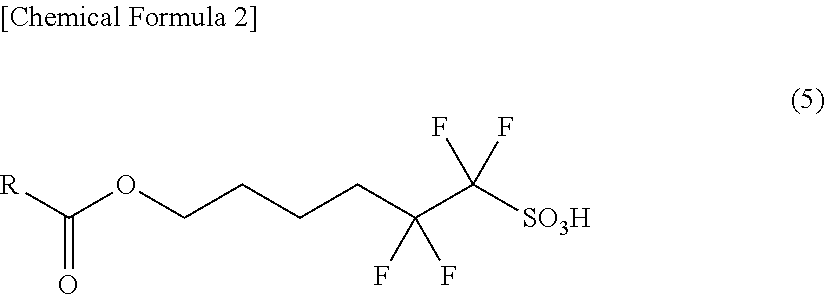Novel Sulfonic Acid Salt and Derivative thereof, Photo-Acid Generator, and Process for Production of Sulfonic Acid Salt
a technology derivative thereof, which is applied in the field of new sulfonic acid salt and a derivative thereof, and the production process of sulfonic acid salt, can solve the problems of reduced mask-dependence, low etching resistance, and increased mask-dependence of photoresist, so as to increase the acid strength and adjust the boiling point or solubility of a sulfonic acid. , the effect of increasing the acid strength
- Summary
- Abstract
- Description
- Claims
- Application Information
AI Technical Summary
Benefits of technology
Problems solved by technology
Method used
Image
Examples
example 1-1
Production of 2-(4-Bromo-3,3,4,4-Tetrafluorobutyl)-Malonic Acid Diethyl Ester
[0204]
[0205]In nitrogen atmosphere, 1900 mL of dimethylformamide was prepared with the addition of 320 g (7.17 mol) of sodium hydride (60% mineral oil-containing product), followed by putting it in an iced bath with the addition of 1208 g (7.17 mol) of diethyl malonate. After 1 hour of stirring, 2400 g (7.17 mol) of 1-bromo-1,1,2,2-tetrafluoro-4-iodobutane was added to this solution while regulating the reaction solution so as to be not higher than 100° C. After 1 hour of stirring, 1000 mL of 1N hydrochloric acid was added thereto, followed by extracting it with diisopropyl ether. Then, an organic layer was concentrated, followed by distillation under reduced pressure (115-116° C. / 0.53 kPa), thereby obtaining 1940 g of the objective 2-(4-bromo-3,3,4,4-tetrafluorobutyl)-malonic acid diethyl ester (74% yield, 89% GC purity) in the form of a light yellow liquid.
[0206][Properties of 2-(4-Bromo-3,3,4,4-Tetrafluo...
example 1-2
Production of 6-Bromo-5,5,6,6-Tetrafluorohexanoic Acid
[0209]
[0210]7000 g (26.4 mol) of 15% of sodium hydroxide aqueous solution was added to 1940 g (5.29 mol) of the objective 2-(4-bromo-3,3,4,4-tetrafluorobutyl)-malonic acid diethyl ester obtained as discussed above, followed by refluxing it for 2 hours. Upon cooling it to room temperature, 2900 g (29.1 mol) of concentrated hydrochloric acid (36%) is added in an iced bath, followed by extraction with diisopropyl ether. A residue obtained by distilling a solvent off was heated to 170° C. thereby obtaining 1338 g of the objective 6-bromo-5,5,6,6-tetrafluorohexanoic acid (95% yield) in the form of a brown liquid.
[0211][Properties of 6-Bromo-5,5,6,6-Tetrafluorohexanoic Acid]
[0212]1H NMR (Solvent for measurement: Deuterated chloroform, Reference material: Tetramethylsilane) δ (ppm): 1.86-1.99 (2H, m), 2.05-2.24 (2H, m), 2.42-2.52 (2H, m).
[0213]19F NMR (Solvent for measurement: Deuterated chloroform, Reference material: Trichlorofluorome...
example 1-3
Production of 6-Bromo-5,5,6,6-Tetrafluorohexanoyl Chloride
[0214]
[0215]In nitrogen atmosphere, 780 g (6.33 mol) of thionyl chloride was added to 1300 g (4.87 mol) of the 6-bromo-5,5,6,6-tetrafluorohexanoic acid obtained as discussed above, followed by stirring at 50° C. for 4 hours. Then distillation was conducted under reduced pressure thereby obtaining 1223 g of the objective 6-bromo-5,5,6,6-tetrafluorohexanoyl chloride in the form of a light yellow liquid (88% yield, 91% GC purity).
[0216][Properties of 6-Bromo-5,5,6,6-Tetrafluorohexanoyl Chloride]
[0217]1H NMR (Solvent for measurement: Deuterated chloroform, Reference material: Tetramethylsilane) δ (ppm): 1.97-1.05 (2H, m), 2.09-2.24 (2H, m), 3.02 (2H, t, J=7.1 Hz).
[0218]19F NMR (Solvent for measurement: Deuterated chloroform, Reference material: Trichlorofluoromethane) δ (ppm): −66.4 (2F, brs), −112.6 (2F, brdd, J=21 Hz, 9 Hz).
PUM
| Property | Measurement | Unit |
|---|---|---|
| wavelength | aaaaa | aaaaa |
| wavelength | aaaaa | aaaaa |
| etching resistance | aaaaa | aaaaa |
Abstract
Description
Claims
Application Information
 Login to View More
Login to View More - R&D
- Intellectual Property
- Life Sciences
- Materials
- Tech Scout
- Unparalleled Data Quality
- Higher Quality Content
- 60% Fewer Hallucinations
Browse by: Latest US Patents, China's latest patents, Technical Efficacy Thesaurus, Application Domain, Technology Topic, Popular Technical Reports.
© 2025 PatSnap. All rights reserved.Legal|Privacy policy|Modern Slavery Act Transparency Statement|Sitemap|About US| Contact US: help@patsnap.com



